London (1 night): It was a warm evening and we sat in the back courtyard of a pub, drinking pint after pint of wonderful British ale with our London friend, Mike Fitzpatrick.
Rome
(3 nights): We arrived in Rome, via Ryan Air (of course), taking a bus
from the Campiano airport to the train station and, from there, the metro
to the Vatican area. From the Lepanto metro stop, it was a short walk
to Pensione Paradise, a small “hotel” on the top
floor of a building. Our room was pleasant and looked down over the inner
courtyard.
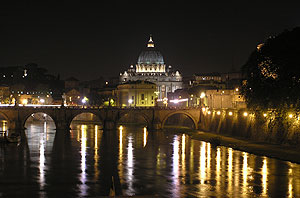 We
walked and walked and walked, finally having dinner that night at a restaurant
highly recommended in our guidebook (Lonely Planet): Otello alla Concordia,
great food – especially the rucola (called arugula here –
it’s now planted and thriving in our garden). And then we wandered
slowly through the neighbourhoods and the Vatican area to our hotel.
We
walked and walked and walked, finally having dinner that night at a restaurant
highly recommended in our guidebook (Lonely Planet): Otello alla Concordia,
great food – especially the rucola (called arugula here –
it’s now planted and thriving in our garden). And then we wandered
slowly through the neighbourhoods and the Vatican area to our hotel.
Highlights in Rome were this restaurant and another in Trastevere that
had fabulous thin-crusted pizza and the gelati cones eaten late at night
in the lively Piazza Navona .
And, of course, the sense of history that is everywhere.
Very early on the Wednesday morning, we walked over to St. Peter’s
Square to watch people begin to arrive to see the pope at his open-air
audience. Instead of waiting with them, 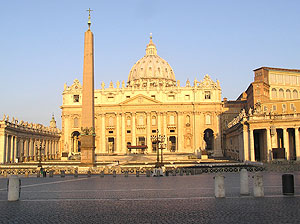 we
went off to find a cappuccino and then to line up at the entrance to the
Vatican Museum. We were among the first to enter it that day. The art
was as spectacular and as overwhelming as one would expect. But, then,
this can be said of all of Rome. When we had finished the museum tour,
we went back to St. Peter’s Square to see the crowds leaving and,
as they thinned out, we found a spot from which to get a good look at
the pope himself. Stooped down, of course, and sitting on his papal thrown,
he was offering blessings to those (mostly brightly dressed children)
who came up to kneel before him. It was sunny and, by then, getting very
hot so we wandered off to tour other parts of the city – the Spanish
Steps, and Via del Corso.
we
went off to find a cappuccino and then to line up at the entrance to the
Vatican Museum. We were among the first to enter it that day. The art
was as spectacular and as overwhelming as one would expect. But, then,
this can be said of all of Rome. When we had finished the museum tour,
we went back to St. Peter’s Square to see the crowds leaving and,
as they thinned out, we found a spot from which to get a good look at
the pope himself. Stooped down, of course, and sitting on his papal thrown,
he was offering blessings to those (mostly brightly dressed children)
who came up to kneel before him. It was sunny and, by then, getting very
hot so we wandered off to tour other parts of the city – the Spanish
Steps, and Via del Corso.
Thursday started cloudy so after scouting out the train station where
we were to pick up the car the next day, we walked to Trastevere where
we discovered one of our favourite restaurants for lunch (and supper)
– the best thin crusted pizza we’re ever enjoyed and worth
going back for.
On the morning of our departure from Rome, we made our way back to the
train station to pick up our car. The first thing George had said when we started to plan the trip was that
he would not drive in Italy – especially not in Rome. So, when he
went to pick up the car, he was told that this was his lucky day. The
small car (the Fiat Punto) we had ordered was not available; so, they
handed him the keys to our Saab convertible. The first challenge was getting
it out of the parking spot into which it was squeezed; the next was getting
out of Rome (and there were many more challenges to follow).
The first thing George had said when we started to plan the trip was that
he would not drive in Italy – especially not in Rome. So, when he
went to pick up the car, he was told that this was his lucky day. The
small car (the Fiat Punto) we had ordered was not available; so, they
handed him the keys to our Saab convertible. The first challenge was getting
it out of the parking spot into which it was squeezed; the next was getting
out of Rome (and there were many more challenges to follow).
Orvieto
(1 night): We made our way out of the city, driving north past vineyards
to the hilltop town of Orvieto.  This
ancient Etruscan city was, especially after dark and very early in the
morning when the tourist population had virtually vanished, as magical
as our guidebook said it would be. Our little hotel (Hotel Corso) right
in the midst of the old part of the city was charming and, once George
managed to drive the Saab up the hill/mountain and along some of the narrow
laneways the locals called streets and find the parking lot, we settled
in. The highlight here, aside from the simple pleasure of being in this
ancient town, was the tour of the underground caves that turned out to
be fascinating – especially for what it told us of how the people
of the town had solved practical problems like water and food. Over thousands
of years a network of caves (about a thousand in all) had been carved
into the rock (volcanic tufa easily quarried and shaped) and these caves
served a variety of purposes – wells bringing water all the way
up from the base of the hill, pressing oils and grapes, animal stall,
etc. One of the fascinating things we learned was that the citizens of
the town (that was often under siege for years at a time) solved their
food problem by building “pigeon holes” in the underground
caves. Pigeons who called these holes “home” were free to
come and go (and so feed themselves) through little window-like holes
in the outer walls and in turn, they were the food for the citizens. All
of the ancient houses in Orvieto had their own cave – usually now
these are used as natural wine cellars.
This
ancient Etruscan city was, especially after dark and very early in the
morning when the tourist population had virtually vanished, as magical
as our guidebook said it would be. Our little hotel (Hotel Corso) right
in the midst of the old part of the city was charming and, once George
managed to drive the Saab up the hill/mountain and along some of the narrow
laneways the locals called streets and find the parking lot, we settled
in. The highlight here, aside from the simple pleasure of being in this
ancient town, was the tour of the underground caves that turned out to
be fascinating – especially for what it told us of how the people
of the town had solved practical problems like water and food. Over thousands
of years a network of caves (about a thousand in all) had been carved
into the rock (volcanic tufa easily quarried and shaped) and these caves
served a variety of purposes – wells bringing water all the way
up from the base of the hill, pressing oils and grapes, animal stall,
etc. One of the fascinating things we learned was that the citizens of
the town (that was often under siege for years at a time) solved their
food problem by building “pigeon holes” in the underground
caves. Pigeons who called these holes “home” were free to
come and go (and so feed themselves) through little window-like holes
in the outer walls and in turn, they were the food for the citizens. All
of the ancient houses in Orvieto had their own cave – usually now
these are used as natural wine cellars.
Assisi
(1 night): 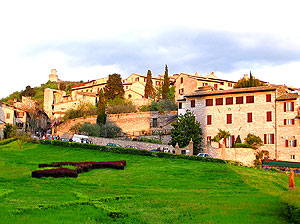 Finally
(after close to half an hour) figuring out how to lower the roof of our
convertible – not an easy feat when all the mechanisms are electronic
and the instructions are in Italian, we drove out of Orvieto. It was a
sunny day and while driving through the vineyards of Umbria toward Assisi
we could (finally) come to appreciate the Saab. As we approached the hillside
town of Assisi, it looked lush and green and peaceful. It was described
in our guidebook as “a tranquil refuge despite the millions of tourists
it attracts” but we found it anything but tranquil. After walking
the long route up from the lower parking area, what we found was a tourist
town infested by, for us, far too many tourists. It was the Saturday of
a holiday weekend (May Day); so, we should have expected the scene that
greeted us. We were lucky to find a place to stay – a hotel recommended
in Lonely Planet (Hotel Sole) right in the center of the old part of the
town – our room was on the top floor – many, many flights
of stairs up but worth the climb as it was both comfortable and quiet.
Finally
(after close to half an hour) figuring out how to lower the roof of our
convertible – not an easy feat when all the mechanisms are electronic
and the instructions are in Italian, we drove out of Orvieto. It was a
sunny day and while driving through the vineyards of Umbria toward Assisi
we could (finally) come to appreciate the Saab. As we approached the hillside
town of Assisi, it looked lush and green and peaceful. It was described
in our guidebook as “a tranquil refuge despite the millions of tourists
it attracts” but we found it anything but tranquil. After walking
the long route up from the lower parking area, what we found was a tourist
town infested by, for us, far too many tourists. It was the Saturday of
a holiday weekend (May Day); so, we should have expected the scene that
greeted us. We were lucky to find a place to stay – a hotel recommended
in Lonely Planet (Hotel Sole) right in the center of the old part of the
town – our room was on the top floor – many, many flights
of stairs up but worth the climb as it was both comfortable and quiet.
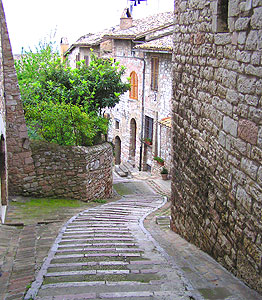 And,
once again, George managed to drive the car up into the city, through
the crowds and to a parking area designated for the use of hotel guests.
As he drove up through the ancient gates, the hordes of tourists slowly
parted to let him drive through. It was very hot and, given the number
of tourists, we were rather wishing that we had stayed in Orvieto. That
feeling stayed with us probably until the morning (except for an hour
or so we spent watching the flag throwing – beautiful colours and
great skill) when we got up early to visit the church of St. Francis.
St. Francis was born here in 1182 and the Basilica de San Francesco, comprising
two churches, one built on top of the other; work on the lower one started
in 1228 (two years after St. Francis died) and work on the upper one started
two years later. We went into the lower church and made our way to the
small chapel to see the various mementos of St Francis’ life, including
his shirt and sandals, and fragments of his ‘Canticle of the Creatures,’
and then walked down the stairs to reach the crypt containing his tomb.
Buried here, along with St. Francis, were many of his followers. This
scene was lovely – very earthy and remarkably peaceful; it made
the visit to Assisi worthwhile. Before leaving we bought five small tiles
that matched the outside of our house and these are now positioned near
our front door, providing our street number (731) in a decorative and
visible way.
And,
once again, George managed to drive the car up into the city, through
the crowds and to a parking area designated for the use of hotel guests.
As he drove up through the ancient gates, the hordes of tourists slowly
parted to let him drive through. It was very hot and, given the number
of tourists, we were rather wishing that we had stayed in Orvieto. That
feeling stayed with us probably until the morning (except for an hour
or so we spent watching the flag throwing – beautiful colours and
great skill) when we got up early to visit the church of St. Francis.
St. Francis was born here in 1182 and the Basilica de San Francesco, comprising
two churches, one built on top of the other; work on the lower one started
in 1228 (two years after St. Francis died) and work on the upper one started
two years later. We went into the lower church and made our way to the
small chapel to see the various mementos of St Francis’ life, including
his shirt and sandals, and fragments of his ‘Canticle of the Creatures,’
and then walked down the stairs to reach the crypt containing his tomb.
Buried here, along with St. Francis, were many of his followers. This
scene was lovely – very earthy and remarkably peaceful; it made
the visit to Assisi worthwhile. Before leaving we bought five small tiles
that matched the outside of our house and these are now positioned near
our front door, providing our street number (731) in a decorative and
visible way.
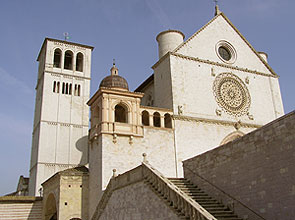 |
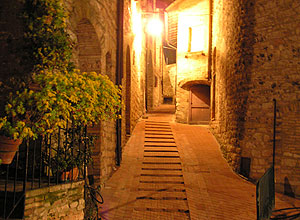 |
Montepulciano
(3 nights): We left mid morning and drove from Umbria into central Tuscany,
stopping in the early afternoon at the hilltop town of Montepulciano.
 Again
we parked rather far down the hill and had to walk a long, long way up
in search of the little hotel, “Bellavista”, highly recommended
in our Lonely Planet guide. When we finally found it, we used the phone
outside to call the owner, Gabriella, (no-one lived on the premises) and,
when we finally reached her, she said that she had a room and would be
over in 10 minutes. When Gabriella finally arrived, she led us up a short
staircase to our room. It looked fine, not only was it clean but it even
had a bathroom complete with a hairdryer. But when she opened the shutters,
the view was literally breath-taking – across the red thatched rooftops
and colourful medieval flags flying in the breeze, vineyards extended
below as far as one could see. I sat on the bed staring out the window
while George found his way back to the car and made his way up the hill
(trying to follow the directions that had been given to him and getting
lost several times) and then through the narrow, winding streets (including
some impossibly sharp turns) to the area right next to the hotel where
he had been told he could park. It took him a very long time…and
he came in looking hot and frazzled. I was still sitting on the bed and,
by then, a bit tearful; looking out the window, it had occurred to me
that finally I had my very own “room with a view.” So, I got
George to sit down by the window too; we opened and contentedly drank
a bottle of red wine. That evening I embarrassed George by getting locked
not only in the washroom but in the “Men’s Washroom”
– something the waitress loudly announced in Italian as she walked
through the crowded restaurant carrying the key. Only later did George
understand why everyone turned, laughing, to look at him. Luckily, it
wasn’t a great restaurant and we had no intention of returning to
the scene of this embarrassment.
Again
we parked rather far down the hill and had to walk a long, long way up
in search of the little hotel, “Bellavista”, highly recommended
in our Lonely Planet guide. When we finally found it, we used the phone
outside to call the owner, Gabriella, (no-one lived on the premises) and,
when we finally reached her, she said that she had a room and would be
over in 10 minutes. When Gabriella finally arrived, she led us up a short
staircase to our room. It looked fine, not only was it clean but it even
had a bathroom complete with a hairdryer. But when she opened the shutters,
the view was literally breath-taking – across the red thatched rooftops
and colourful medieval flags flying in the breeze, vineyards extended
below as far as one could see. I sat on the bed staring out the window
while George found his way back to the car and made his way up the hill
(trying to follow the directions that had been given to him and getting
lost several times) and then through the narrow, winding streets (including
some impossibly sharp turns) to the area right next to the hotel where
he had been told he could park. It took him a very long time…and
he came in looking hot and frazzled. I was still sitting on the bed and,
by then, a bit tearful; looking out the window, it had occurred to me
that finally I had my very own “room with a view.” So, I got
George to sit down by the window too; we opened and contentedly drank
a bottle of red wine. That evening I embarrassed George by getting locked
not only in the washroom but in the “Men’s Washroom”
– something the waitress loudly announced in Italian as she walked
through the crowded restaurant carrying the key. Only later did George
understand why everyone turned, laughing, to look at him. Luckily, it
wasn’t a great restaurant and we had no intention of returning to
the scene of this embarrassment.
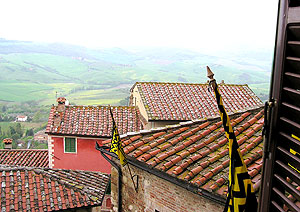
The next morning I didn’t want to leave my “room with a view”
so we booked it for a second night. We went for a ride that day searching
for vineyards at which to taste wines (to Pienza and Montalcino) only
later in the day, to discover that all we had to do was wander around
the town to sample olive oil, wines and other delicacies of the region
and to tour caves where wine and olive oil was stored and which, often,
contained museum-like exhibits of remnants of a previous age – including
instruments of torture as well as implements for making olive oils and
wines. That night we found a great restaurant (Osteria Acquachenta) where
we met, sitting at the next table, a young couple whom we now view as
our Italian friends. We were trying to translate the menu (and my dictionary
wasn’t of much help) when the woman at the next table asked us in
perfect English if we needed some help. She went down the list, translating
for us, and George and I ordered our meals. I had a very spicy pasta and
George devoured fresh anchovies and a pasta with a sauce of wild boar.
We chatted with this young couple, Harriet & Adriano (the Baker),
at one point asking them what had happened to the Italian hostages in
Iraq whom we understood were to be beheaded in Iraq if Italians did not
give a sufficiently strong protest cry about the war. They didn’t
know and Adriano explained in Italian (as Harriet translated) that Italians
care more about things close to home such as what gets a flower to bloom.
His comment began later to make sense as we thought about the centuries
of wars and political upheavals the Italians have managed to survive –
with day-to-day life (and passion for life) remarkably intact. They were
also kind enough to offer a few suggestions of places to visit.
The next morning again I didn’t want to leave my “room with
a view” and, by that time, was actually saying that I never wanted
to leave. 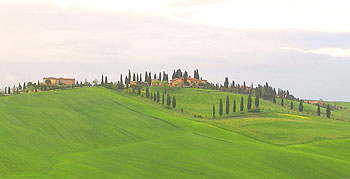 So,
we booked another night and took a drive to Sienna, intending to book
a room there for the next night. It was a somewhat dreary day, gray and
often raining; so, we were less than thrilled (with again over-crowded)
Sienna. We did find a fantastic restaurant called “Il Carroccio”
(again recommended in our Lonely Planet) – it was crowded but we
found a spot at a wooden table and had a great lunch. We walked through
the town, deciding after a short walk that it was too much like a tourist
town. We headed back toward Montepulciano, stopping at a few of the spots
Harriet and Adriano had recommended. The first was a small hilltop town
(devoid of tourists) of Monteriggoni and then the very popular S. Gimignamo.
The third was a restaurant at old Roman bath ruins, owned by a friend
of theirs. We were told to announce on arrival that “the baker”
had sent us. Sadly, it was closed. The setting (ancient Roman baths perched
on top of a hill) however was as spectacular as they had described –
especially at dusk with a full moon above. We raced back to Montepulciano
intending to go back to our restaurant of the previous night. Unfortunately,
it was closed too; so, we found another one (Ristorante al Quattro Venti)
– almost as great.
So,
we booked another night and took a drive to Sienna, intending to book
a room there for the next night. It was a somewhat dreary day, gray and
often raining; so, we were less than thrilled (with again over-crowded)
Sienna. We did find a fantastic restaurant called “Il Carroccio”
(again recommended in our Lonely Planet) – it was crowded but we
found a spot at a wooden table and had a great lunch. We walked through
the town, deciding after a short walk that it was too much like a tourist
town. We headed back toward Montepulciano, stopping at a few of the spots
Harriet and Adriano had recommended. The first was a small hilltop town
(devoid of tourists) of Monteriggoni and then the very popular S. Gimignamo.
The third was a restaurant at old Roman bath ruins, owned by a friend
of theirs. We were told to announce on arrival that “the baker”
had sent us. Sadly, it was closed. The setting (ancient Roman baths perched
on top of a hill) however was as spectacular as they had described –
especially at dusk with a full moon above. We raced back to Montepulciano
intending to go back to our restaurant of the previous night. Unfortunately,
it was closed too; so, we found another one (Ristorante al Quattro Venti)
– almost as great.
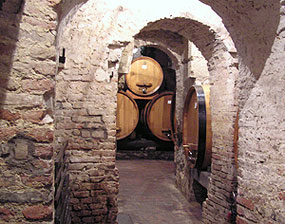 |
 |
The next morning I still didn’t want to leave but, sadly, we packed up and vacated our room (room #2, Bellavista Camere, 53045 Montepulciano (SI), Sede Via Ricci, 25, Fisc.: Via D. Galimberti, 4, Tel. 347 8232314 – 3382291964) intending to drive to Florence. But it was starting to rain and the rain fell harder and harder as we drove on and, about an hour outside of Florence, we spontaneously changed our plan. George had looked at a weather report that morning which indicated that the sun was shining in one (and only one) spot in all of Italy; so, that’s where we headed. On the way, we stopped briefly at the town of Arezzo. It had been heavily bombed during WWII and was the setting for much of Roberto Benigni’s film Life is Beautiful. It was raining lightly as we wandered up to the town center to find our morning cappuccino. It was well worth getting a bit wet and we’re intending to rent the film again. The town to which we were headed was on the Adriatic coast and getting there meant driving out of Tuscany and across the province of Marche that, as we soon discovered, is 65% high mountain ranges.
Senigalia
(1 night); The drive was fantastic. Time and time again, we thought that
we had circled up the mountain as far as we could possibly go but still
we kept climbing. It seemed that we were climbing all the way into the
heavens. The roads, of course, were winding and narrow – George,
by now quite accustomed to our Saab, loved it. It was so heavily misty
that we could only rarely get a sense of what lay below and of how precariously
near sharp declines we were. After several hours we reached a hill town
called “Urbino.” It was a long, steep climb up into this ancient
town, famous for having been the home of Raphael. We didn’t tour
the house he was born in though we did consider staying at a hotel right
next door to it. But it was still raining; so, we just walked around,
thinking of how spectacular the view would be if only we could see through
the mist and the rain. We drove on, becoming by now a bit concerned about
getting to the Adriatic coast in time to find somewhere to stay for the
night. When we got to the coast, the sun was shining and our spirits picked
up. We stopped at Senigalia and found a room (at a hotel called Albergo
Eleaonora recommended in Lonely Planet). Our room, this time with balcony
with a view of the Adriatic, (and of the beach and beach houses which
reminded us a bit too much of Florida – fortunately it was not yet
tourist season so there were no bathers cluttering the beach) cost us
only 40 Euros. We had dinner at a little restaurant on the beach –
and George had his first true meal of fresh fish. Our waitress, Sabrina,
(charming, attractive, 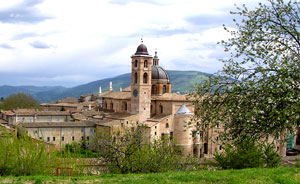 and
with a tattoo on her wrist picturing her recently broken heart) gave George
a whole bottle of limoncello after he asked her about the drink he had
just enjoyed. We went back to our room and sat out on the balcony watching
bats dart about in the night sky. The next morning we set off retracing
our steps back to Urbino, hoping that by now the rain would have stopped
there and that we could explore that town and get some pictures. The rain
had stopped but that brought out those darn tourists so we took another
of those unexpected turns, driving again across Marche (but this time
not through the mountains), and arriving in Gubbio, situated on the northern
edge of Umbria.
and
with a tattoo on her wrist picturing her recently broken heart) gave George
a whole bottle of limoncello after he asked her about the drink he had
just enjoyed. We went back to our room and sat out on the balcony watching
bats dart about in the night sky. The next morning we set off retracing
our steps back to Urbino, hoping that by now the rain would have stopped
there and that we could explore that town and get some pictures. The rain
had stopped but that brought out those darn tourists so we took another
of those unexpected turns, driving again across Marche (but this time
not through the mountains), and arriving in Gubbio, situated on the northern
edge of Umbria.
Gubbio
(2 nights): 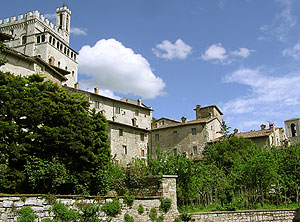 There
isn’t much to say except that I loved Gubbio (at least as much as
Montepulciano) and that I want to go back. We found a room at the Hotel
San Marco (recommended, of course, in Lonely Planet). It dates from the
1300’s when it was a convent and our room looked out on the inner
courtyard. We walked a bit and had dinner that night at a simple but excellent
restaurant on a side street. The next day we walked around this incredibly
wonderful, non-touristy medieval town – even getting caught in a
brief hailstorm (and getting drenched) didn’t weaken our enthusiasm
for the town. It’s medieval character is, as the guidebook said,
intact, the setting is spectacular, the artwork fabulous and next time
we’ll remember to eat again at Fabiani Ristorante (which is where
we had both lunch and dinner that day) and either stay again at San Marco
or do it a bit cheaper at a lovely smaller hotel called Grotta dell’
Angelo which we scouted out. There are many things we’ll do next
time, including take the funicular device up the 1000 meters to the hilltop
to visit the burial site of the town’s saint.
There
isn’t much to say except that I loved Gubbio (at least as much as
Montepulciano) and that I want to go back. We found a room at the Hotel
San Marco (recommended, of course, in Lonely Planet). It dates from the
1300’s when it was a convent and our room looked out on the inner
courtyard. We walked a bit and had dinner that night at a simple but excellent
restaurant on a side street. The next day we walked around this incredibly
wonderful, non-touristy medieval town – even getting caught in a
brief hailstorm (and getting drenched) didn’t weaken our enthusiasm
for the town. It’s medieval character is, as the guidebook said,
intact, the setting is spectacular, the artwork fabulous and next time
we’ll remember to eat again at Fabiani Ristorante (which is where
we had both lunch and dinner that day) and either stay again at San Marco
or do it a bit cheaper at a lovely smaller hotel called Grotta dell’
Angelo which we scouted out. There are many things we’ll do next
time, including take the funicular device up the 1000 meters to the hilltop
to visit the burial site of the town’s saint.
 |
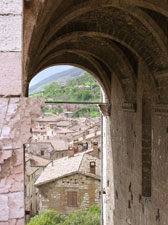 |
Rome
(3 nights): 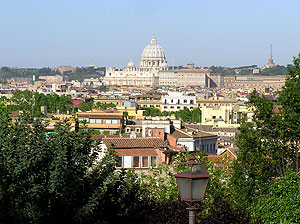 The
drive into Rome proved to be quite a harrowing one – getting lost,
which we managed to do, and having a deadline for getting the car back
to the rental office (at the downtown Train Station – Metro termini),
made it tense. But George managed (I’ll never know how) to find
his way.
The
drive into Rome proved to be quite a harrowing one – getting lost,
which we managed to do, and having a deadline for getting the car back
to the rental office (at the downtown Train Station – Metro termini),
made it tense. But George managed (I’ll never know how) to find
his way.
It was sunny and with minor delays found our hotel on Via della Croce.
Not nearly as nice as our earlier Vatican choice, the rooms were on the
fourth floor (actually by American standard the fifth floor) and we had
to lug ourselves and our luggage up too many stairs and, on arrival, were
(for the first time on this trip) disappointed. It was OK but we wouldn’t
go back to this one.
The change from the country to the city was a shock and we had to deal
with a brief sense of wistful melancholy for Gubbio et al. But food and
wine helped.
We did enjoy our visit to the Catacombs (the tour down into one small
section and the view of the 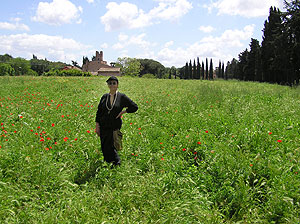 fields
of poppies that were left untouched because the Catacombs were below left
a strange but peaceful feel); the hours spent strolling through the
fields
of poppies that were left untouched because the Catacombs were below left
a strange but peaceful feel); the hours spent strolling through the
Forum and seeing the layers of history brought home to us the reality
of ancient history; and some great meals at the favorite restaurants we
had discovered at the start of our trip made those last few days a good
memory. We also discovered another great restaurant – “Al
34” at which we had a fabulous meal, so fabulous, in fact, that
we wanted to return the next night – unfortunately it was closed.
On the last day, we did (finally) go shopping – nothing fancy, just
an outdoor market (near Porta San Giovanni) where George found a great
jacket and a straw hat.
London (1 night): Not much to say – we got to Evensong at Westminster Abbey and had a simple dinner in a pub. But we just wanted to go home and get back to Italy.
We arrived home on
May 12 with fantasies of the next trip. George bought me a book called
“Too Much Tuscan Sun” for my birthday (just a few
days later) and a card (featuring one of the pictures he had taken in
Gubbio); it said “Next year Gubbio.”